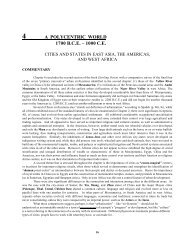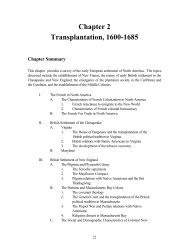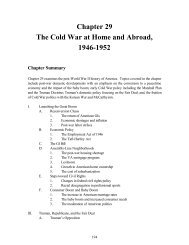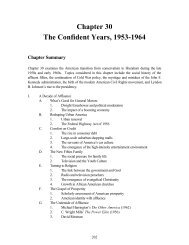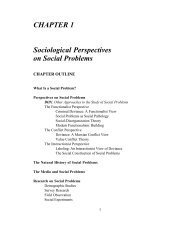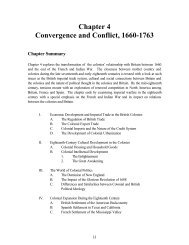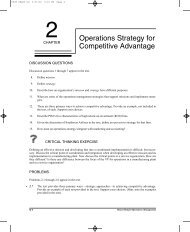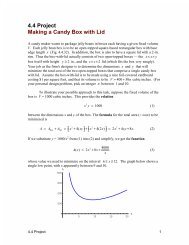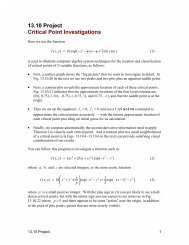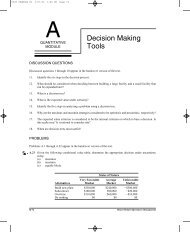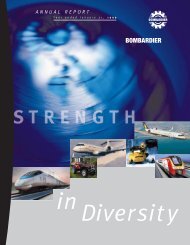Merchandising Operations and the Accounting Cycle - Pearson
Merchandising Operations and the Accounting Cycle - Pearson
Merchandising Operations and the Accounting Cycle - Pearson
You also want an ePaper? Increase the reach of your titles
YUMPU automatically turns print PDFs into web optimized ePapers that Google loves.
Assignment Material<br />
Questions<br />
1. Gross margin is often mentioned in <strong>the</strong> business<br />
press as an important measure of success. What<br />
does gross margin measure, <strong>and</strong> why is it important?<br />
2. Describe <strong>the</strong> operating cycle for (a) <strong>the</strong> purchase<br />
<strong>and</strong> cash sale of inventory, <strong>and</strong> (b) <strong>the</strong> purchase<br />
<strong>and</strong> sale of inventory on account.<br />
3. Identify ten items of information on an invoice.<br />
4. Indicate which accounts are debited <strong>and</strong> credited<br />
under <strong>the</strong> perpetual inventory system for (a) a<br />
credit purchase of inventory <strong>and</strong> <strong>the</strong> subsequent<br />
cash payment, <strong>and</strong> (b) a credit sale of inventory<br />
<strong>and</strong> <strong>the</strong> subsequent cash collection. Assume no discounts,<br />
returns, allowances, or freight.<br />
5. Inventory costing $1,000 is purchased <strong>and</strong> invoiced<br />
on July 28 under terms of 3/10 n/30. Compute <strong>the</strong><br />
payment amount on August 6. How much would<br />
<strong>the</strong> payment be on August 9? What explains <strong>the</strong><br />
difference? What is <strong>the</strong> latest acceptable payment<br />
date under <strong>the</strong> terms of sale?<br />
6. Inventory listed at $35,000 is sold subject to a quantity<br />
discount of $3,000 <strong>and</strong> under payment terms<br />
of 2/15 n/45. What is <strong>the</strong> net sales revenue on this<br />
sale if <strong>the</strong> customer pays within 15 days?<br />
7. Name <strong>the</strong> new contra accounts introduced in this<br />
chapter.<br />
8. Briefly discuss <strong>the</strong> similarity in computing supplies<br />
expense <strong>and</strong> computing cost of goods sold by<br />
<strong>the</strong> method shown in Exhibit 5-12 on page 247.<br />
9. Why is <strong>the</strong> title of Cost of Goods Sold especially<br />
descriptive? What type of account is Cost of<br />
Goods Sold?<br />
Exercises<br />
256 Part One The Basic Structure of <strong>Accounting</strong><br />
10. Beginning inventory is $5,000, net purchases total<br />
$30,000, <strong>and</strong> freight in is $1,000. If ending inventory<br />
is $8,000, what is cost of goods sold?<br />
11. You are evaluating two companies as possible investments.<br />
One entity sells its services; <strong>the</strong> o<strong>the</strong>r<br />
entity is a merch<strong>and</strong>iser. How can you identify <strong>the</strong><br />
merch<strong>and</strong>iser by examining <strong>the</strong> two entities’ balance<br />
sheets <strong>and</strong> income statements?<br />
12. You are beginning <strong>the</strong> adjusting <strong>and</strong> closing process<br />
at <strong>the</strong> end of your company’s fiscal year. Does <strong>the</strong><br />
trial balance carry <strong>the</strong> final ending amount of<br />
inventory? Why or why not?<br />
13. Give <strong>the</strong> adjusting entry for inventory if shrinkage<br />
is $9,100.<br />
14. What is <strong>the</strong> identifying characteristic of <strong>the</strong> “o<strong>the</strong>r”<br />
category of revenues <strong>and</strong> expenses? Give an example<br />
of each.<br />
15. Name <strong>and</strong> describe formats for <strong>the</strong> two income<br />
statements <strong>and</strong> identify <strong>the</strong> type of business to<br />
which each format best applies.<br />
16. List eight different operating expenses.<br />
17. Which financial statement reports sales discounts<br />
<strong>and</strong> sales returns <strong>and</strong> allowances? Show how <strong>the</strong>y<br />
are reported, using any reasonable amounts in your<br />
illustration.<br />
18. Does a merch<strong>and</strong>iser prefer a high or low rate of inventory<br />
turnover? Explain.<br />
19. In general, what does a decreasing gross margin<br />
percentage, coupled with an increasing rate of inventory<br />
turnover, suggest about a business’s<br />
pricing strategy?<br />
Exercise 5-1 Evaluating a company’s revenues, gross margin, operating income, <strong>and</strong> net<br />
income (Obj. 1)<br />
The Toy Store Inc. reported <strong>the</strong> information shown on page 257:<br />
Required<br />
1. Is The Toy Store Inc. a merch<strong>and</strong>ising entity, a service business, or both? How can<br />
you tell? List <strong>the</strong> items in The Toy Store Inc. financial statements that influence<br />
your answer.<br />
2. Compute The Toy Store Inc.’s gross margin for fiscal years 2004 <strong>and</strong> 2003. Did <strong>the</strong><br />
gross margin increase or decrease in 2004? Is this a good sign or a bad sign about<br />
<strong>the</strong> company?<br />
3. Write a brief memo to <strong>the</strong> president advising her of The Toy Store Inc.’s trend of<br />
sales, gross margin, <strong>and</strong> net income. Indicate whe<strong>the</strong>r <strong>the</strong> outlook for The Toy<br />
Store Inc.’s is favourable or unfavourable, based on this trend. Use <strong>the</strong> following<br />
memo format:



